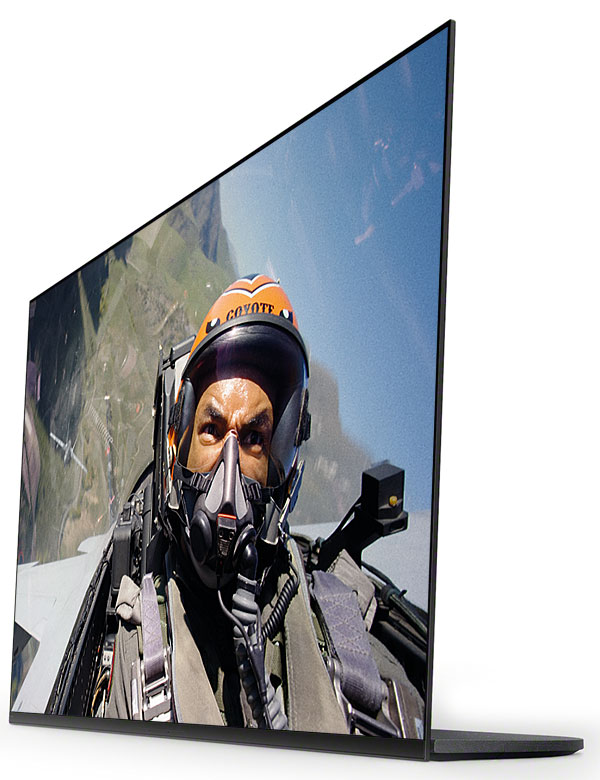Sony XR-55A95K 55in Quantum Dot OLED TV Review

 This Quantum Dot OLED flatscreen is the TV to beat right now, believes John Archer
This Quantum Dot OLED flatscreen is the TV to beat right now, believes John Archer
Samsung isn't the only brand to combine OLED's self-emissive contrast talents and the brightness/colour benefits of Quantum Dots in a TV this year. Sony is also in on the QD OLED act with its A95K series, in 55in (tested here) and 65in versions that command a premium over Samsung's already discounted S95B model. Is the extra cost justified?
Aesthetically the £2,399 XR-55A95K (the 65-incher sells for a toppy £3,199) couldn't be more different to Samsung's first-gen QD OLED set. That TV has an incredibly thin, smart metallic finish, whole Sony's is a chunky beast by modern standards. There's still something stylish about it in an industrial kind of way, though, and I appreciate having the choice of whether to attach it to the front or back of its heavy-duty metal stand.
There's an excuse for its bulk in the shape of Sony's Acoustic Surface audio tech, where actuators behind the screen that turn it into the TV's speaker system are backed up by two bass drivers built into the set's rear. We've heard Acoustic Surface technology on Sony OLED TVs before, of course, and it works just as well with QD OLED screens. The pulsating Dolby Atmos soundtrack of Baz Luhrmann's Elvis (4K Blu-ray) sounds consistently excellent through the XR-55A95K: dynamic, open and clean, with accurate effects placement both on and beyond the screen.
Just The Two Of Us
The TV's connections are reasonably strong, with two of its four HDMIs supporting 4K/120Hz feeds, as well as variable refresh rates and automatic low latency mode switching. PS5 owners can also enjoy auto HDR optimisation, while image lag in Game mode is kept to a respectable 16.5ms with 60Hz sources.

You might expect, at this price, for all four HDMI inputs to handle the full suite of gaming features, given that they do on Samsung's S95B and LG's C and G series OLEDs. Additionally, the XR-55A95K doesn't support Dolby Vision gaming at 4K/120Hz – in fact, it won't play Dolby Vision at all unless you make sure the feature is enabled from the TV's connection menus.
HDR10+ playback is not on the menu at all, with Sony claiming it can ape HDR10+ with its own processing systems. We'd still like to see the company's TVs joining Panasonic, TCL and Philips in supporting all main HDR formats.
Image processing is handled by is Sony's latest Cognitive XR system. This sees the Japanese major refining the processor's approach of subtly manipulating myriad elements in any incoming image, to try and make it look more as your eye perceives the real world. On paper this might get some home cinema enthusiasts thinking the XR-55A95K isn't interested in delivering accurate pictures. Actually, though, the set is packed with independently certified settings, including Netflix Calibrated and IMAX Enhanced options, offering you a route to relative accuracy if that's what you want (as we'll see, the Cognitive XR 'juiced' pictures are quite gorgeous, however). Furthermore, the XR-55A95K is Calman Ready if you want to go the professional calibration route.
The TV's smart features are, as usual with Sony TVs, provided by Google TV. This is mostly good news, at least to the extent that the interface is a nice presentational and organisational refinement on its Android TV predecessor, and carries a colossal amount of content. It also enables support for Google Casting and Google Assistant voice recognition, and there's a nice Sony-specific wrinkle to the smart platform in the shape of the Bravia Core streaming service, which enables film fans (with sufficient broadband speeds) to watch 4K HDR movies delivered at bitrates of up to 80Mbps.
Unleash The Spectacle
At first glance the XR-55A95K's image performance doesn't feel like it's delivering as much of a QD OLED 'bonus' as that of the Samsung S95B range. Pictures are not quite as bright or aggressively dynamic. Yet it doesn't take long before you begin to realise that, while the screen's take on QD OLED might not be as dramatic as Samsung's, it's certainly not any less impressive. In fact, I'd say it's even better.
 |
Home Cinema Choice #351 is on sale now, featuring: Samsung S95D flagship OLED TV; Ascendo loudspeakers; Pioneer VSA-LX805 AV receiver; UST projector roundup; 2024’s summer movies; Conan 4K; and more
|

















































